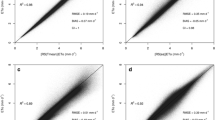Summary
Daily values of global radiation from 10 stations for the period 1950–1960 are used as a base to describe the distribution of the global radiation of solar energy in the Intermontane Basin and Plateau Region of the western United States (including areas of the States from Washington and Idaho in the North to the Mexican frontier in the south). The empirical relations between radiation and more commonly available climatic and geographic variables—percent of possible sunshine, mean daily cloud cover, presence or absence of snow on the ground, optical air mass, and station elevation and latitude—are established through regression and correlation analysis for these stations and used to estimate radiation at 16 additional locations where radiation data are not collected. This provides better geographic coverage than could be obtained from use of radiation data alone. The technique also permits the filling-in of missing data in the records of the 10 stations to provide each with a complete record for the study period. Selected monthly maps of mean daily global radiation are presented for the region.
Zusammenfassung
Tagessummen der Globalstrahlung von 10 Stationen aus der Periode 1950 bis 1960 werden verwendet, um die Verteilung der Globalstrahlung von Sonne und Himmel im Westen der Vereinigten Staaten (Intermontane Basin und Plateau Region, umfassend Gebiete der Staaten von Washington und Idaho im Norden bis zur mexikanischen Grenze, jedoch unter Ausschluß der tieferen Lagen von Kalifornien) darzustellen. Die empirischen Beziehungen zwischen Strahlung und anderen, allgemeiner verfügbaren klimatischen und geographischen Variabeln — wie relative Sonnenscheindauer, Tagesmittel der Himmelsbedeckung, Vorhandensein oder Fehlen einer Schneedecke, optische Luftmasse, Meereshöhe und Breite der Station —werden durch Regressions- und Korrelationsanalyse für diese Stationen aufgestellt und dazu benützt, um für weitere 16 Orte, für welche keine Strahlungsbeobachtungen vorliegen, die Strahlungswerte abzuschätzen. Dadurch wird die geographische Verteilung besser erfaßt als lediglich durch die vorhandenen Strahlungsdaten. Das gleiche Verfahren gestattet auch, fehlende Werte in den Aufzeichnungen der Ausgangsstationen zu ergänzen und dadurch die Reihen zu vervollständigen. Eine Auswahl von Monatskarten der mittleren Tagessumen der Globalstrahlung für das Gebiet wird vorgelegt.
Résumé
Pour représenter la répartition du rayonnement global du soleil et du ciel dans l'ouest des Etats-Unis, on s'est servi des sommes journalières du dit rayonnement recueillies à 10 stations pendant la période allant de 1950 à 1960. La région considérée comprend les bassins versants et les hauts plateaux s'étendant des Etats de Washington et de l'Idaho au nord jusqu'à la frontière du Méxique au sud, mais à l'exception des terres basses de la Californie. Afin d'estimer les valeurs de la radiation globale en 16 stations différentes, mais où elle n'est pas mesurée, on s'est servi de rapports empiriques entre la dite radiation et les éléments météorologiques ou géographiques généralement disponibles. Ceux-ci sont: la durée d'insolation relative, la nébulosité journalière moyenne, la présence ou l'absence d'une couche de neige, l'épaisseur optique de la masse d'air, l'altitude et la latitude du lieu. Les rapports empiriques utilisés sont calculés au moyen d'une analyse en régressions et en corrélations. On peut alors mieux se rendre compte de la répartition géographique réelle de la radiation globale qu'en se servant des seuls relevés effectués. Les mêmes procédés permettent en outre de combler les lacunes que présentent les mesures faites aux stations de base afin d'obtenir des séries complètes pour la période entière. On présente enfin un choix de cartes de la région, cartes contenant les moyennes mensuelles de la somme journalière de la radiation globale.
Similar content being viewed by others
References
Kimball, H. H.: Variations in the Total and Luminous Radiation with Geographical Position in the United States. Mon. Wea. Rev.47, 769 to 793 (1919).
Ångström, A.: Solar and Terrestrial Radiation. Quart. J. Roy. Met. Soc.50, 121–126 (1924).
Black, J. N.: The Distribution of Solar Radiation over the Earth's Surface. Arch. Met. Geoph. Biokl. B7, 165–189 (1956).
Ezekiel, M., andK. A. Fox: Methods of Correlation and Regression Analysis, Linear and Curvilinear. New York, 1959.
Mateer, C. L.: A Preliminary Estimate of the Average Insolation in Canada. Canad. J. Agric. Sci.35, 579–594 (1955).
Reitan, C. H.: Mean Monthly Values of Precipitable Water Over the United States, 1946–1956. Mon. Wea. Rev.88, 25–35 (1960).
Fritz, S.: Solar Radiation on Cloudless Days Heating and Ventilating46, 69–74 (1949).
Drummond, A. J., andE. Vowinckel: The Distribution of Solar Radiation Throughout Southern Africa. J. Met.14, 343–353 (1957).
Glover, J., andJ. S. G. McCulloch: The Empirical Relation Between Solar Radiation and Hours of Sunshine. Quart. J. Roy. Met. Soc.84, 172–175 (1958).
Budyko, M. I.: Atlas Teplovogo Balansa (Heat Balance Atlas), Glavaniia Geofizicheskaia Observatoria im. A. I. Voeikova. Leningrad, 1955.
Fritz, A., andT. H. MacDonald: Average Solar Radiation in the United States. Heating and Ventilating46, 61–64 (1949).
Author information
Authors and Affiliations
Additional information
With 12 Figures
Rights and permissions
About this article
Cite this article
Bennett, I. A method for preparing maps of mean daily global radiation. Arch. Met. Geoph. Biokl. B. 13, 216–248 (1964). https://doi.org/10.1007/BF02243254
Issue Date:
DOI: https://doi.org/10.1007/BF02243254




